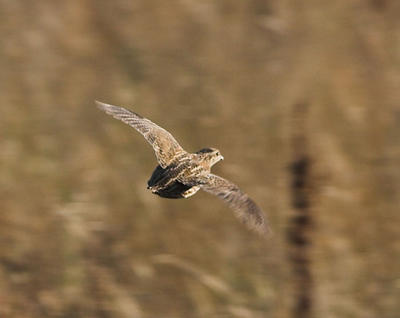
Quail:
On May 17th two calling males arrived in Worlaby Carrs with an arrival of migrants which included Temminck’s Stint and Pectoral Sandpiper. During June I found at least five males calling and saw what appeared to be at least two females. All of these were in a different area to the May birds. At least four birds were calling through July with one heard briefly on August 14th. Since then I have not had cause to walk the fields very much as breeding bird surveys were completed.
With recent flooding of the grasslands following the week’s heavy rain today I walked some of the wetter areas to look for Snipe. Not 100m into the first field I was amazed to flush a Quail late morning. It called on rising and gave an excellent view as it shot low across the field and dropped into the long grass. On October 27th this seemed somewhat astounding. During the afternoon in a different area I was even more shocked when I flushed three Quail together! Presumably a family party. I had a strong assumption that the species would have bred at Worlaby this year given the strong territorial behaviour of the males and the length of their stay in favoured habitat but to find four different bird albeit on a balmy and spring like late October day was totally unexpected. As the three birds got up I had my camera ready having been photographing flying Meadow Pipits (yes I know it’s a silly idea) and managed to get the auto-focus onto one bird.
So how unusual is this record. I have done a quick search through my literature and have produced a quick summary below. Comments are welcome.
Quail are essentially a summer migrant in Britain usually arriving from mid May to June or even early July. Once males stop calling birds ‘disappear’ and only flushing birds by walking suitable habitat is likely to reveal their continued presence. Autumn departures are somewhat protracted and usually unseen. Autumn migration starts in August with peak movements across the Mediterranean in mid September. There are rare winter records in Britain, just four were noted in Norfolk between 1970 and 2004, and it appears that statements in many county avifaunas and National works regarding winter occurrences were based mainly on more plentiful records in the 19th century.
The text for Quail in the original Birds of Lincolnshire 1952 noted ‘single birds have been seen occasionally in winter’. In a Supplement to the Birds of Lincolnshire 1954-1968 Atkin and Townsend only mention Quail under casual breeding with no mention of any extra-ordinary occurrences while the most recent avifauna “Atkin and Lorand” states: ‘Most birds occur during the period May to September but occasional birds have been noted in winter’. So is the statement regarding winter occurrences in Lincolnshire a repetition of the statement in the original work or have there been other more recent winter records?
Looking through all the county reports from 1979 to 1996 revealed the following records outside the April to August period:
Stoke Rochford September 26th 1971, Donna Nook November 3rd 1980 and most recently Nocton Fen December 30th 1995. This last bird was found ‘around Pheasant pens and appeared to be of wild origin’; the association with tame game bird may have been coincidental but Quail are also kept in captivity.
The only records of bevies of young birds found in the county have referred to July and August.
No comments:
Post a Comment